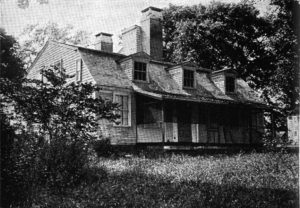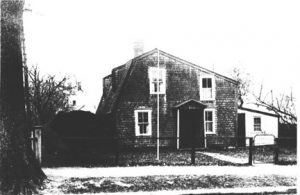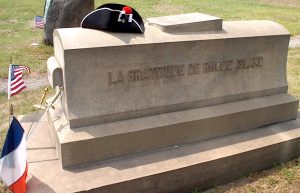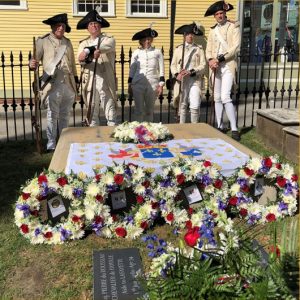Louis-Dominique Éthis de Corny (1736–1790),Commissioner of War, came to America aboard the French warship Hermione along with Maj. Gen. Marie Jean Paul Joseph du Motier Marquis de Lafayette in April 1780. Corny’s assignment was to procure everything necessary for the arrival of the expédition particulière, the army of about 5800 troops under Lieutenant General Jean Baptiste Donatien de Vimeur Comte de Rochambeau due to arrive in America in the summer of 1780. Corny needed to buy horses for the artillery and the cavalry, food, firewood, straw and forage, and to secretly gather general information about the country. He submitted his report to his supervisor Claude Blanchard, Chief Commissary of War.[1] He also established hospitals for the many soldiers who would arrive sick from the voyage or contract illnesses after they landed.
Providence
Corny selected locations for hospitals in Providence, Bristol and Newport. The hospital in Providence was in an “abandoned building of the college.”[2] The building wasn’t actually abandoned. The College of Rhode Island, which later became Brown University, ceased operation during the war years. It was commandeered as a hospital first for the Continental Army and then for the French army. This hospital was expected to house 650 sick soldiers. Claude Blanchard and hospital administrator Jean Baptiste de Mars or Demars de Grandpré visited this hospital frequently, and General Rochambeau visited on August 26, 1780.[3]
Poppasquash

A second hospital was established at Poppasquash (also known as Pappoose-Squaw Neck, Papasquash Neck, Poppysquash and Popasquash Neck).[4] Barracks were constructed on two farms on this neck of land during the years 1755 and 1756.[5] French prisoners were kept there during the French and Indian War and the area became known as Barrack Meadow. Some prisoners were supposedly buried there, but no graves have ever been identified.
On July 4,1780, Ethis de Corny informed the French Minister to the United States in Philadelphia that he had established a hospital at Poppasquash as a second auxiliary hospital (hôpital de provision) between Providence and Newport. This was, strictly speaking, an entrepôt, or summer hospital built of wood. James Craik,[6] assistant director general of the hospitals (precursor of the Surgeon General), had this mediocre establishment built.
The Poppasquash hospital consisted of seven barracks for the sick, two double kitchens, a pharmacy, a bakery, a laundry, and a house for the director, chaplain, medical officer and their assistants. The hospital was expected to house 350 sick; this hospital and the one in Providence could accommodate a total of 1,000 patients. A few patients were brought to the Poppasquash hospital on July 14 and 15, 1780, and a “great number” were brought there on July 16. There were 280 patients there on July 19 and 23.[7] There were also some locations in Tiverton to accommodate patients with infectious diseases, to prevent their spread.[8]

Some people place the hospital at the southern tip of the Poppasquash peninsula, but the east side offered better protection, having an artillery battery about 1,000 yards west-northwest and another about 1,200 yards southwest. One of the barracks was moved across the harbor on the ice in 1784 by a team of six oxen, and used by the town of Bristol as a dwelling house for the poor.[9] It was on the west side of High Street, between Bradford and Franklin Streets. It was torn down in January 1961 and replaced by the present house at 325 High Street.[10]
Corny’s July 4 letter implied that the buildings were not useable during the winter months and they seem to have been empty at the time of the arrival of Armand Louis de Gontaut–Biron, Duc de Lauzun’s hussars. General Rochambeau wrote to Admiral Charles Louis d’Arsac Chevalier de Ternay on July 28 to arrange for transportation of the sick from the Poppasquash hospital to Providence.[11] It was shut down in early August 1780.
Newport
As the French had 800 soldiers and 1,500 sailors ill in July 1780,[12] more hospital space was needed. The Royal Deux Ponts Regiment, composed of men of German heritage, had 300 of them; it appears that the Germans felt the heat more and were more subject to scurvy than the French.[13]
The navy had its own hospitals aboard ships and “the Newport City Hall and some churches were taken for the same purpose.”[14] Commissioner of War Claude Blanchard recorded that the Baptist church was selected as a hospital on July 18, 1780;[15] General Rochambeau ordered a sergeant’s guard (a sergeant, corporal and twelve men) to be posted there daily beginning on July 23, 1780.[16] Rochambeau visited the sick and attended mass at the hospital that same day.[17] A sergeant’s guard was also placed at Wood’s Castle, the landing site, and a captain’s guard (a captain, lieutenant, and ninety men) was posted around the camp. These were the only guards posted daily during the entire French sojourn in Rhode Island.
The Baptist church, located at what is now the corner of Barney and Spring Streets), was among those used as a hospital.[18] The church no longer exists, but the pulpit is at the Newport Historical Society nearby. The Newport hospital had about 400 patients on July 23, 1780.[19]
Illnesses
Louis François Bertrand Dupont d’Aubevoye, Comte de Lauberdière (1759-1837), General Rochambeau’s nephew and aide-de-camp, was also an assistant quartermaster general. He noted in his journal that three-quarters of the sick had scurvy.[20] Claude Blanchard wrote that there were 500 sick on September 8, many with dysentery.[21] He also noted that there were about 500 men ill in Providence and more than 200 in Newport—10 percent of the army.[22] The remaining sick may have had ague (malaria) or cholera, common illnesses in Continental Army camps. Those camps also had a high incidence of smallpox, but it’s not likely that smallpox affected the French in Rhode Island because those soldiers were usually inoculated for smallpox at the time of enlistment.[23]
Jean-François Coste (1741-1819), chief army physician, and Dr. Fiacre Robillard, the chief surgeon, cared for the sick. They were assisted by navy physicians. Chief among them were Dr. Larat de Lafitte, an assistant surgeon on board the Duc d Bourgogne who cared for the sick in Newport almost single-handedly, for which he received a bonus of 300 livres in 1782. The medical personnel of the Ardent also played an important role at the Newport hospitals, particularly Jean-Honoré Lauger and Jean-Baptiste Barras, both draft surgeons, and François Morand (d. 1782) and René Couesnon, both surgeon’s assistants.[24]
Surgeons of several other vessels also cared for the sick at Newport, such as Pierre Eraud of the Fantasque, who served ashead surgeon at the Newport hospitals. The Marquis de Lévis’s surgeon-major also assisted. Adrien Le Padrun, draft apothecary aboard the Ardent, served these hospitals as pharmacist. François Auvray, Pierre-François le Vigoureux, Noël Donval and several other sailors of la Provence were selected for the duties of infirmarian because many of the sick from this ship were being treated at the Newport hospitals.[25]

August and September 1780 were the most lethal months for the French. Of the 27 deaths in Providence in 1780 and 1781, 44 percent of them occurred in August and September. Similarly, 35 percent of the 153 deaths in Newport occurred during the same time.[26] Patients at the Poppasquash hospital were moved to Providence and the hospital was closed before any casualties occurred there.
The dead were usually buried in unmarked graves so as not to give any indication of depleted troop strength. Consequently, it is impossible to identify where any of them are buried. Those who died in Providence are commemorated by a cenotaph in the city’s North Burial Ground. The monument is to the right of the grave of Col. Israel Angell (1740–1832), commander of the 2nd Rhode Island Regiment.
Most of the soldiers who died in Newport were probably buried at the Common Burial Ground or at the Baptist Burial Ground.[27] The site of the latter is not known but it may have been near the intersection of Warner St. and Callendar Ave. as there was a Baptist church on Callendar Ave. at one time.

Admiral de Ternay was buried at Trinity Church, the only Frenchman to have a gravestone. On September 10, 2021 two other headstones were placed aside of de Ternay’s grave to honor Capt. Pierre du Rousseau, Chevalier de Fayolle (1746-1780) and 2nd Lt. Augustin Benjamin de la Villemarais (1733-1780). The former was buried in an unmarked grave at Trinity Church while the latter was buried at the Baptist Burial Ground. As that burial ground no longer exists, his stone was placed next to de Ternay’s along with Fayolle’s.
General Rochambeau was already beginning to plan the army’s departure from Newport and the march to New York by April 30, 1781, but the army couldn’t be ready before the beginning of June.[28] He convened a council of war on May 31 during which it was decided that Brig. Gen. Claude Gabriel Marquis de Choisy (1723-1800) would remain at Rhode Island with one hundred men per regiment and the siege artillery to protect the town and the navy vessels remaining there until further orders. When they departed to go south to join the rest of the army, Major De Prez of the Deux Ponts regiment remained at Providence with one hundred men with orders to guard the magazines and hospital there.[29] Any soldiers remaining in the hospitals at Boston, Providence, Hartford and anywhere else along the route were expected to rejoin their regiments on their own or return to France upon recovery.
[1]Blanchard’s summary of Corny’s report is dated July 19, 1780 and can be found in Jean-Baptiste-Donatien de Vimeur, comte de Rochambeau, papers, 1777-1794, Library of Congress MSS38067, 15:1-7.
[2]The location of the Providence hospital is at map coordinates 41.826218932622524, -71.40387741840895.
[4]The name Pappoose-Squaw may derive from an account that a Wampanoag squaw and her papoose fled across the harbor in a canoe during the Indian Wars and hid from her pursuers at the Neck before the English settlement of Bristol in 1680. National Register of Historic Places Inventory-Nomination Form: Poppasquash Farms Historic Dictrict, United States Department of the Interior Heritage Conservation and Recreation Service, 14. Allan Forbes and Paul F Cadman, France and New England (Boston: Walton, 1927), 2:147-148.
[5]The barracks were located at the De Wolfe/Vassall farm (ca. 1740), 158 Poppasquash Road (map coordinates 41.67202957924451, -71.29128118961233), and Nathaniel Byfield’s, 333 Poppasquash Road (map coordinates 41.66460899634892, -71.29218636391883).
[6]George Washington to William Greene, Morristown, May 5, 1780, Records 9:87, 149, Letters to the Governor (Rhode Island State Archives), 14:110; Rhode Island State Archives, Minutes/Proceedings of the Council of War, C#00253, 4:112-113; Letters from the Governor (Rhode Island State Archives), 4:18; Washington to William Heath, Morristown, June 2, 1780; William Heath, Memoirs of Major General William Heath (New York: New York Times, 1968), 253; Dominique-Louis-Ethis de Corny to Washington, July 6, 1780, founders.archives.gov/documents/Washington/99-01-02-02388; George Washington, The writings of George Washington from the original manuscript sources, 1745-1799, John C. Fitzpatrick, ed.(Washington, DC: Government Printing Office, 1931-44) 18:467-468.
[7]Claude Blanchard, The Journal of Claude Blanchard, Commissary of the French Auxiliary Army sent to the United States during the American Revolution (Albany, NY: J. Munsell, 1876, reprint by New York Times and Arno Press, 1969), 43-46.
[8][Acts and resolves]. At the General Assembly of the governor and company of the English colony of Rhode-Island and Providence Plantations in New-England in America, begun and held at South-Kingstown within and for said colony, on the last Wednesday in October [1747], in the twenty-first year of the reign of his most Sacred Majesty George the Second [to the last Monday in October, one thousand eight hundred.] (Newport? 1747-1800). June 1780:11-12.
[9]Bristol, Rhode Island, Town Meeting Records, Book 3, 1781-1811, p. 17.
[10]Susan E. Cirillo and Lombard John Pozzi. Bristol: three hundred years
(Providence, R.I.: Franklin Graphics, 1980); Wilfred Harold Munro, The History of Bristol, R.I.: The Story of the Mount Hope Lands, from the Visit of the Northmen to the Present Time. Containing Accounts of the Indian Wars, the Character and Lives of the Early Settlers in Bristol, the Events of the Revolution, the Privateers of the War of 1812, Details of the Commerce of the Port, and Sketches of Its Distinguished Men (Providence: J.A. & R.A. Reid, 1880),242.
[11]Rochambeau to de Ternay, July 28, 1780. Rochambeau papers 8:51; Robert A. Selig,The Washington-Rochambeau Revolutionary Route in the State of Rhode Island, 1780 – 1783: An Architectural and Historical Site Survey and Resource Inventory, 417, w3r-us.org/history-by-state/.
[12]Rochambeau to Prince de Montbarey, French War Minister July 25, 1780; Rochambeau to Washington July 30, 1780; Rochambeau papers 8:51.
[13]Blanchard. Op. cit. p. 46. The ship Ile de France, with 350 men of the second division of the Bourbonnais regiment and fifty tons of gunpowder aboard, had become separated from the fleet and went to Boston. When it arrived, it had about 100 soldiers and sailors ill. A makeshift hospital was immediately set up at “William Island” (Castle William in Boston Harbor).
[14]Louis François Bertrand Dupont d’Aubevoye Lauberdière, The Road to Yorktown: The French Campaigns in the American Revolution, 1780-1783, Norman Desmarais, trans. ed. (El Dorado Hills, CA: Savas Beatie, 2020), 31. These locations do not appear in Ethis de Corny’s report.
[15]Blanchard, The Journal of Claude Blanchard, 44.
[16]Armée de Rochambeau: Livre d’ordre contenant ceux donnés depuis le débarquement des troupes à Newport en Amerique septentrionale. July 23, 1780, Archives Départmentales de Meurthe & Moselle.
[17]Blanchard, The Journal of Claude Blanchard, 45.
[18]Map coordinates 41.49002460299766, -71.31244379018933.
[19]Blanchard, The Journal of Claude Blanchard, 46.
[20]Lauberdière, The Road to Yorktown, 31.
[21]Blanchard, The Journal of Claude Blanchard, 63.
[23]Smallpox was introduced to the French navy and army in the spring of 1781 by some ships captured in the Chesapeake Bay. The first cases were taken to American hospitals, but the French established a hospital capable of treating 100 sick a few days later. French soldiers, sailors and Black prisoners were admitted indiscriminately. Maurice Bouvet, Le Service de Santé Français Pendant la Guerre d’Indépendance des États-Unis (1777-1782) (Paris: Hippocrate, 1934), 74.
[26]Norman Desmarais, “The French Soldiers Commemorated at the North Burial Ground in Providence” smallstatebighistory.com/the-french-soldiers-commemorated-at-the-north-burial-ground-in-providence/; Norman Desmarais, “The French Soldiers Who Died at Newport During the Revolutionary War,” smallstatebighistory.com/french-soldiers-who-died-at-newport-during-the-revolutionary-war/).
[27]Charles Carroll, Rhode Island: Three Centuries of Democracy (New York: Lewis Historical Publishing, 1932), 344.







Recent Articles
That Audacious Paper: Jonathan Lind and Thomas Hutchinson Answer the Declaration of Independence
Supplying the Means: The Role of Robert Morris in the Yorktown Campaign
Revolution Road! JAR and Trucking Radio Legend Dave Nemo
Recent Comments
"Eleven Patriot Company Commanders..."
Was William Harris of Culpeper in the Battle of Great Bridge?
"The House at Penny..."
This is very interesting, Katie. I wasn't aware of any skirmishes in...
"Texas and the American..."
Mr. Villarreal I would like to talk to you about Tejanos who...